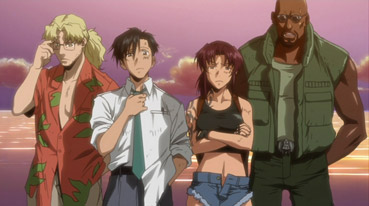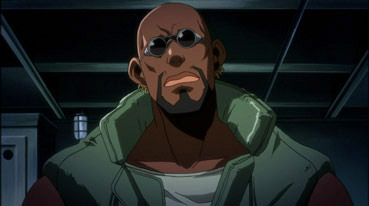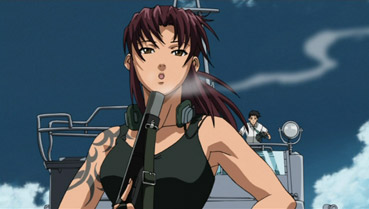|
Although there are a lot of animes in the 'Gun Girl' genre, Black Lagoon mixes in a lot of extra features from other styles of anime. There are comedy moments interspersing the seriousness of the action that can take up the whole of other shows of this ilk.
There is a good mix of characters, none of which are annoying. A lot of generic anime shows have a thing about throwing in random, irritating characters that the rest of the cast pick on for comedy moments. Black Lagoon is a lot more creative in this respect in that – although Rock is the guy who gets picked on, he is also very reflective. He takes life in his step, and is able to think about situations differently to the rest of the mercenary group.

The core characters that are first introduced in this DVD release are Rock, Dutch, Revy and Benny.
Rock, who is initially introduced as Rokuro Okajima, gets his shortened nickname (that lasts for the rest of the season) from Dutch. He is introduced at the start of the show as a Japanese hostage and as events unfold, it is revealed that Rock works for a large Japanese corporation, who has an unofficial front working in the black market. The reason for Rock being taken hostage is that, while carrying an important data disk, he is deemed to be worth more money by Revy through demanding a ransom for his safe return.
One of the long-running themes in the show is how Revy and Rock are always paired off on their missions, while Dutch and Benny watch over from a distance. The first few episodes on the DVD do not go into details about the characters' pasts, but the limited background given is that Dutch fought as a soldier in the Vietnam war, Revy grew up in New York, referenced by her appreciation for subway graffiti, and Benny seems to have got involved in a similar way to Rock, by no direct fault of his own.
Eventually Rock becomes written off by his employer and marked for death to cover up any illegal activities. You almost feel emphatic towards Rock when discarded and written off in Japan as a dead man, however he doesn't show any concern or emotion. There is no display of loss from himself, towards his family for example, which implies that he had a very secluded life that he didn't care much for within the world of Japanese office politics.
If you enjoy the first two episodes, the rest of the anime gets further in depth in all of the aspects visited, including character histories, relationships and other exciting missions. There is a point in the 3rd episode that has a quick look at Revy's dark past, however there is little detail and it opens up questions that are later answered in the series. Things are action based from the offset and by the end of the 2nd episode you know exactly what to expect from the rest of the series (although there are some very cool twists along the way that any respectable anime show should have).

Black Lagoon is built up through many smaller stories – the majority revolve around the missions picked by Dutch for the group and can be watched individually, however an underlying story runs throughout that ties everything together. This setup is apparent right from the third episode, which is based around events within the fictional city of Roanapur, where the Black Lagoon Mercenaries base their operations from. Balalaika is introduced, who is a key employer of their "services" and plays an increasingly larger role as the series progresses (especially into Black Lagoon: 2nd Barrage).
The intro itself is wholly anime, and what you would expect from this kind of show, but at the same time it is incredibly well done. The music draws you in and watching the scenes flash in sequence with the beat really gets the adrenaline going. Although it is standard anime fair, it is the polish that shows through that makes the show so entertaining. The animation quality, music choice and voice actors, everything ties together. Someone who isn't a huge anime fan might not appreciate this and see it as just another anime intro, but for those who appreciate the art form will see the entertainment value right from the opening lyrics of "its all up to you."
The ending sequence takes a while to get used to as the music fades in while the last 15 seconds of the show are still taking place. This can be very confusing at times and take you by surprise, because if you are really concentrating on what is happening the end credits sometimes appear out of nowhere, although this can also be seen as testament to how engrossing the anime can be at times.
A standard NTSC to PAL transfer with the usual strengths and weaknesses found on MVM anime discs – colour and detail are good, but there's some slight ghosting on fast character and camera movement. The framing is 16:9 and the picture is enhanced for widescreen TVs.
The choice of soundtracks is between Japanese stereo 2.0 and English 5.1. Obviously your selection with be governed largely by language preference, and we always prefer the Japanese original here. In terms of sound quality the two track are surprisingly close – both are clear and well mixed, although the surrounds are well used for location sound on the 5.1 track and it comes into its own during the action sequences. Bass and directional effects are particularly good here.
Sometimes the English translations are pretty poor compared to the original Japanese original, in this case the usual phrases that can be picked out of any modern anime are recognisably translated. There are a few places where words and explanations have been changed for the English-speaking public, but these seem more for the benefit of the voice actors fitting longer or shorter sentences that have been translated from Japanese to English and this does not detract from the storyline.

With regards to the English voice acting, it is passable and I'm sure people who have no interest in watching the original language version will find it wholly enjoyable, however on a personal level, I detest American voice acting due to their lack of believable enthusiasm. It does not portray the original acting by the Japanese voice cast. This is understandable to a degree, though, due to voice acting being an art form in its own right in Japan, compared to the Disney-isms that have been learnt in the western world through decades of animated shows being aimed towards children and young teenagers. However, it still causes irritation – some of the characters are actually quite well voice-acted, but they are usually peripheral characters. Rock and Revy, being main cast members, sound like adults talking to children instead of getting into the role and acting as their characters do on-screen. Benny and Balalaika are impressive, while others are somewhere between the two extremes.
Although the DVD does not have the clean intro and ending sequences that many people have come to expect, it does have the original Red Fraction music video (4:01) that was released in Japan by the original artist. The video is an interesting diversion and gives the full, uncut music track from the intro to Black Lagoon. Subtitles are shown during the intro to translate the lyrics, most of which are in English – it is surprising how many of the lyrics are in English once it has been translated. The surprise is simply due to the way the words are pronounced differently by a Japanese singer – for example, a word like Angel is pronounced as Angle, but if you did not realise this it can be hard to understand and thus sound foreign to those who do not know the language.
The main extra on the DVD is the usual anime making-of featurette (15:36) that comes with many such DVD releases. It includes snippets of information from the main American voice acting cast and their views on how the characters interact with one another. For the most part it is generic and informative, with a few extra pieces of information that has been dug up that show real-world parallels on the ideas contained within the anime. The voice cast used this to help them internalise who they were trying to be on screen. Unless you are a really interested in the making-of extras from other DVDs, this part probably wont be for you.
Several other top gun girl anime shows such as Madlax, Gunsmith Cats & Gunslinger Girl have same basic theme of girls with guns, loads of shootouts, action, serious undertones with comedy moments to lighten up the show. However, Black Lagoon adds an extra layer of polish that almost all anime fans should be able to appreciate.
|